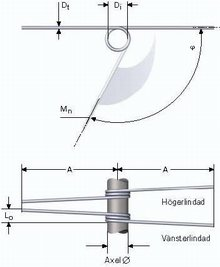Everything you Need to Know About Torsion Springs
What are Torsion Springs?
Torsion springs are a variety of springs that are twisted in a helical fashion. This means that when pressure is applied to the spring it exerts a force called torque in the opposite direction. This mechanism is widely used in products such as clothes pins for example. When you apply pressure to the pin it then exerts torque when released until it is closed, holding the clothes in place.
Another variation of the torsion spring is the torsion bar. This is a straight bar that can be rotated about its axis. These are made of steel and are used generally in heavy duty vehicles as suspension.
Main Uses for Torsion Springs
Torsion Springs have a variety of uses as their impressive rotational energy allows for a transferrable mechanism that can be integrated into many different products.
Firstly, they are commonly used in large vehicles such as trucks, SUVs, or vehicles that generally transport a lot of weight. This is so that the manufacturers can easily change the torsion bars. They do this to change the ride height or compensate for engine weight.
An advantage of torsion springs in vehicles is the durability of the torsion bar as its mass allows it to handle a lot of stress. This is demonstrated by its use in many military vehicles, such as the M1 Abrams tank which has stood the test of time since its development in 1979.
Another popular use for torsion springs is their application within garage doors. The springs are tightly wound around a metal shaft that is connected to a cable drum when the garage door is opened. The tension is released and it spins the shaft, turning the cable drums by wrapping around the drums and raising the door.
When the garage door is closed it winds the torsion spring back around the metal shaft and restores the tension. These springs generally last for around 30,000 cycles; a full cycle consists of both the opening and closing of the garage door.
Torsion springs are also used in the hinges of many doors as it allows them to close after being opened without electronic technology. In theory, it is quite a simple design; the torsion spring is attached to a hinge with one side connected to the stationary plate on the wall and the other side connected to the moving plate on the door.
This means that when the door is opened the pressure applies tension to the torsion spring and once the door is released the rotational energy moves the door back into place.
Their Design
The spring designer must take into consideration how much tension their springs need to undertake to know just how large they need to be. For example, when put under pressure the springs coil diameter will reduce and the length with increase. This means that the metal wire they use needs to be able to bend but return to it’s original shape with ease and have a decent durability which will require little replacement.
As torsion spring manufacturers, we are experts at producing torsion springs to suit your requirements. For more information on our services and products here at European Springs Ireland, please don’t hesitate to get in touch with our expert team here.
[button url=”/contact-us/” class=”scbutton”]Enquire Now[/button]